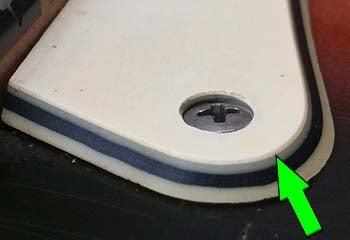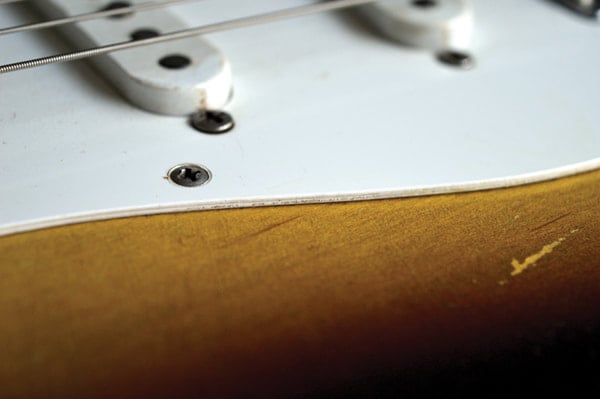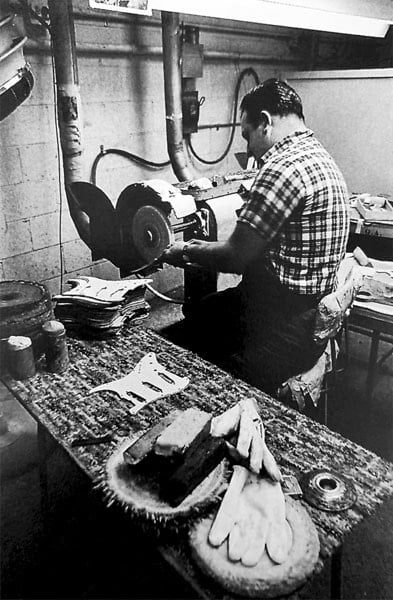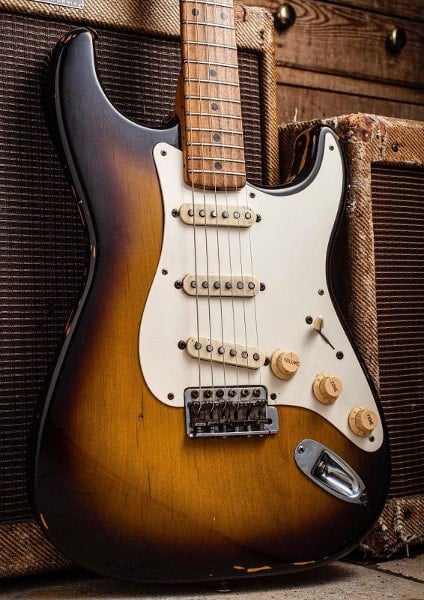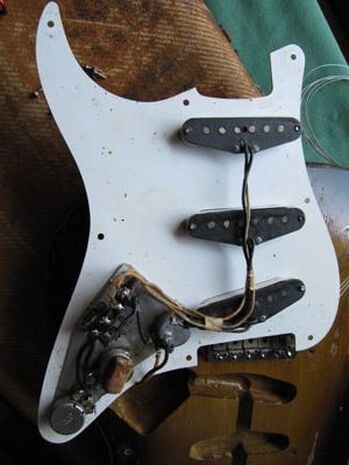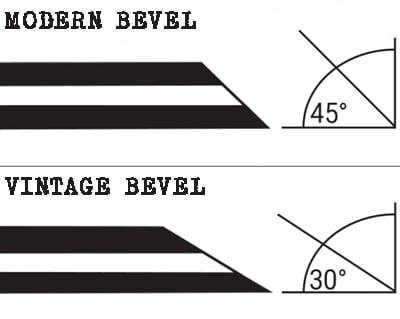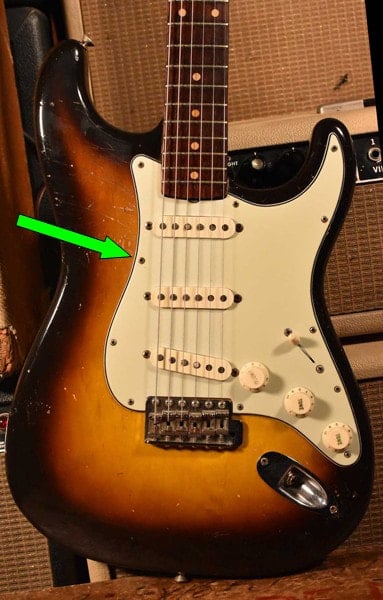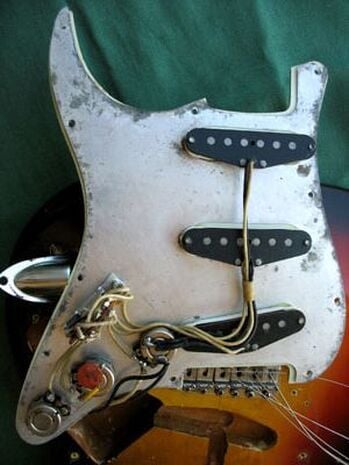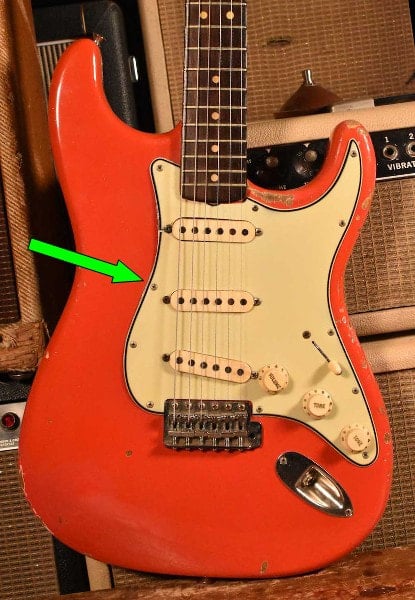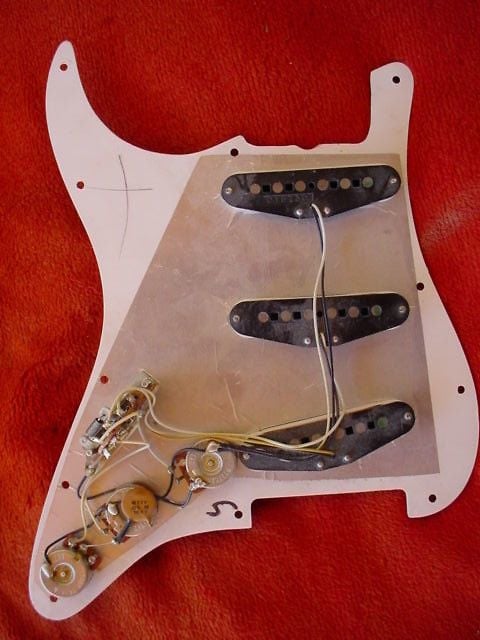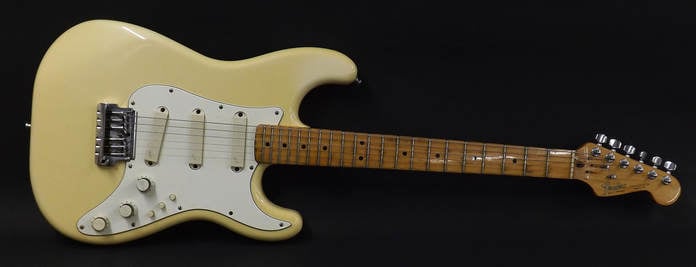1-PLY PICKGUARD
|
Prototypes and samples made in 1953 featured 1-ply black phenolic pickguards as Telecasters. Pre-production and production Stratocasters made between 1954 and mid-1959 were equipped with 1-ply white pickguard ca. .06” thick, fastened to the Stratocaster body with 8 screws.
Contrary to many beliefs, it was not made of bakelite, but of PVC (polyvinyl chloride) or of the new thermoplastic polymer ABS (acrylonitrile butadiene styrene), which were cheap, flexible and easy to work with. The only exceptions were the gold anodized aluminum pickguards available until 1958 at an additional charge. |
A small aluminum shielding plate was attached to the bottom of the pickguard under the control area.
At first, the bottom side of the pickguard was semi-opaque, but, gradually, Fender began to use pickguards which had both top and bottom sides polished.
Stratocasters manufactured between 1954 and 1956 usually featured a date penciled on a piece of masking tape, located underneath the pickguard. These tape inscriptions marked the wiring harness were installed into the body. Therefore, they usually were the last date found on a Fender guitar.
Most of these inscriptions were signed with female first names such as Mary, Gloria, Virginia, or Barbara.
At first, the bottom side of the pickguard was semi-opaque, but, gradually, Fender began to use pickguards which had both top and bottom sides polished.
Stratocasters manufactured between 1954 and 1956 usually featured a date penciled on a piece of masking tape, located underneath the pickguard. These tape inscriptions marked the wiring harness were installed into the body. Therefore, they usually were the last date found on a Fender guitar.
Most of these inscriptions were signed with female first names such as Mary, Gloria, Virginia, or Barbara.
3-PLY “VINTAGE” PICKGUARD
|
In the summer of ’59, 1-ply pickguards were gradually replaced by the famous 3-ply white/black/white pickguards. They were made out of celluloid (nitrocellulose or cellulose nitrate), a material imported from Italy, and were often called nitrate guards.
3-ply pickguards were fastened to the body with 11 screws, although, during a short period of transition – around June 1959 – also hybrid pickguards were used, such as 3-ply (or 1-ply) 10-hole and 3-ply 8-hole pickguards. |
Celluloid even when brand new showed a greyish/greenish (a.k.a. “mint green”) hue. Due to the unstable nature of this material, it became even more “greyish” or “greenish” with ageing and the amount of green/yellow depends on the abuse and UV or smoke the pickguard was subject to. Furthermore, celluloid pickguards also tended to slightly shrink on the edges causing cracks.
Vintage 3-ply pickguards were .100" thick and had a 30° wide bevel, a slightly thicker black layer and a truss rod notch.
A .015” thin full-size aluminum shielding plate was placed underneath the pickguard. A few of them featured some penciled markings. Contrary to many beliefs, these markings were not signatures of employees who carried out the quality control, but actually they were served as a guide to install switches and potentiometers.
It’s important to bear in mind that 3-ply nitro pickguard reproductions are usually made out of cellulose acetate, not cellulose nitrate.
Vintage 3-ply pickguards were .100" thick and had a 30° wide bevel, a slightly thicker black layer and a truss rod notch.
A .015” thin full-size aluminum shielding plate was placed underneath the pickguard. A few of them featured some penciled markings. Contrary to many beliefs, these markings were not signatures of employees who carried out the quality control, but actually they were served as a guide to install switches and potentiometers.
It’s important to bear in mind that 3-ply nitro pickguard reproductions are usually made out of cellulose acetate, not cellulose nitrate.
3-PLY “MODERN” PICKGUARD
In mid-1963 the second upper mounting screw placed half-way between the neck and the middle pickup was relocated closer to the middle pickup.
Since 1968 the aluminum shielding plate was discarded and a thin aluminum foil was attached to the bottom of the pickguard, just around the pots and switch. In 1981 it was enlarged to the pickup area, too.
Since 1968 the aluminum shielding plate was discarded and a thin aluminum foil was attached to the bottom of the pickguard, just around the pots and switch. In 1981 it was enlarged to the pickup area, too.
|
As the celluloid was very flammable and shrunk over time, in early 1964 Fender began to use, along with the classic mint green pickguard, a new one, noticeably whiter, usually called fireproof or 4-ply white celluloid pickguard. In fact, with the aim to use the mint green celluloid guards left in stock that were too dangerous for storage, they added a fourth thin white layer on their top.
In January 1965, Fender began to gradually replace the celluloid pickguards with those in white PVC or ABS plastic, although the “second generation” celluloid guard was used throughout 1965. In 1972 the truss rod notch was discarded. |
In 1973, 3-ply black pickguards (black/white/black) were first used on walnut Stratocasters. From 1975 to 1980, black became the standard trim on all Stratocasters, except for the Antigua models, the Strat (excluding the ‘Walnut Strat’), and the Gold Stratocaster.
In 1981, with the introduction of the short-lived International Colors, white pickguard was again available depending on the finish. A thin aluminum foil was attached to the bottom of the pickguard, just around the pickups and the control area.
With the introduction of the Stratocaster Standard known as “2-Knob Stratocaster”, unveiled in 1983, black pickguards were definitely discontinued in favor of the 1-ply 12-hole pickguard. The additional hole was placed near the jack plug, then relocated on the pickguard assembly.
In 1987 the new American Standard was fitted with a new 3-ply pickguard, recognizable by 45° “modern” bevel edges. It featured a post-63 mounting screw pattern and its holes were not countersunk.
In 1981, with the introduction of the short-lived International Colors, white pickguard was again available depending on the finish. A thin aluminum foil was attached to the bottom of the pickguard, just around the pickups and the control area.
With the introduction of the Stratocaster Standard known as “2-Knob Stratocaster”, unveiled in 1983, black pickguards were definitely discontinued in favor of the 1-ply 12-hole pickguard. The additional hole was placed near the jack plug, then relocated on the pickguard assembly.
In 1987 the new American Standard was fitted with a new 3-ply pickguard, recognizable by 45° “modern” bevel edges. It featured a post-63 mounting screw pattern and its holes were not countersunk.
OTHER PICKGUARDS
Between the beginning of 1962 and 1967, few Stratocasters were fitted with a 4-ply tortoise shell pickguard, similar to those used on the Jazzmaster or the Precision Bass.
Between ’68 and ’70, some 3-ply white pickguards featured a pearloid bottom layer recycled from old Mustang pickguards.
The Elite Stratocaster was fitted with a 3-ply white pickguard fastened to the body with 11 mounting screws. Its second “upper” screw was located roughly half-way between the neck and the middle pickup. It cannot be mistaken for a vintage pickguard because it had a different shape.
The 1982 Vintage Reissue Stratocasters were made with a “replica” of the pre-CBS pickguards. The '57 Stratocaster were fitted with a 1-ply 8-hole white pickguard, whilst the '62 Stratocaster featured a 3-ply 11-hole pickguard. Oddly enough, Fender initially misplaced the second “upper” screw, which was located close to the middle pickup. This detail was later corrected in the same year.
Between ’68 and ’70, some 3-ply white pickguards featured a pearloid bottom layer recycled from old Mustang pickguards.
The Elite Stratocaster was fitted with a 3-ply white pickguard fastened to the body with 11 mounting screws. Its second “upper” screw was located roughly half-way between the neck and the middle pickup. It cannot be mistaken for a vintage pickguard because it had a different shape.
The 1982 Vintage Reissue Stratocasters were made with a “replica” of the pre-CBS pickguards. The '57 Stratocaster were fitted with a 1-ply 8-hole white pickguard, whilst the '62 Stratocaster featured a 3-ply 11-hole pickguard. Oddly enough, Fender initially misplaced the second “upper” screw, which was located close to the middle pickup. This detail was later corrected in the same year.

